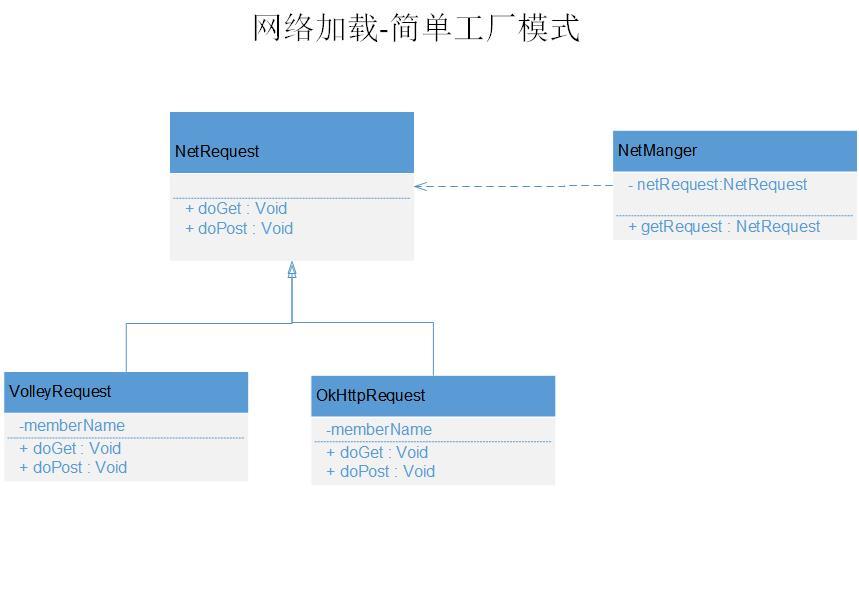Android 二次封装网络加载框架
开发当中,在请求网络的时候,大家或多或少都会使用一些第三方框架,Android-Async-Http、 Volley、XUtils、Okhttp、Retrofit 等。这些框架减少了我们的很多工作量,同时也对侵入了我们的项目。
大家回顾一下手头上的项目代码,是不是或多或少存在这样那样的历史遗留问题,第三方框架调用混乱,没有封装,或者封装不测底。如果要替换框架,很有可能要对项目大动干戈。
封装的必要性
- 随着需求的变更或者时间的迁移,某些框架可能已经不能满足我们的需求,我们需要使用新的框架来代替。
- 对第三方框架进行封装,是为了达到对模块项目的控制,已最小的代价替换框架,达到对项目的控制。
或许你会认为对第三方框架再进行一次封装,没有必要。那是你没有尝试过一行行复制张贴代码,进行替换。
有人可能会想, AS 不是有批量替换的功能吗,干嘛还要封装?
- 首先,你能保证调用到的地方参数都一模一样吗?
- 第二,能用更优雅的方式实现,为什么要用最粗暴的方式去替换。
接下来我们先来看一下 okHttp 的使用
Okhttp 的使用
OkHttpClient.Builder mBuilder= new OkHttpClient.Builder().
connectTimeout(10, TimeUnit.SECONDS).writeTimeout(10, TimeUnit.SECONDS)
.readTimeout(30, TimeUnit.SECONDS)
.addInterceptor(new LoggingInterceptor())
.cache(new Cache(mContext.getExternalFilesDir("okhttp"),cacheSize));
client=mBuilder.build();
Request.Builder builder = new Request.Builder().url(url).tag(option.mTag);
builder=configHeaders(builder,option);
Request build = builder.build();
client.newCall(build).enqueue(new Callback() {
@Override
public void onFailure(Call call, IOException e) {
handleError(e, iResponseListener);
}
@Override
public void onResponse(Call call, Response response) throws IOException {
handleResult(response, iResponseListener);
}
});
复制代码
如果不进行封装,okHttp 请求网络大概是这样的,想一下,如果我们在项目中都这样使用,要替换框架,那花费的工作量要多大。
不过这种方法,在项目中大多数人不会这样使用,至少都会封装成为一个工具类。封装完成之后如下。
public static void doGet(Context context,String url, Map<String, String> paramsMap, NetworkOption networkOption,
final IResponseListener iResponseListener){
OkHttpClient.Builder mBuilder= new OkHttpClient.Builder().
connectTimeout(10, TimeUnit.SECONDS).writeTimeout(10, TimeUnit.SECONDS)
.readTimeout(30, TimeUnit.SECONDS)
.addInterceptor(new LoggingInterceptor())
.cache(new Cache(context.getExternalFilesDir("okhttp"),cacheSize));
OkHttpClient cilent = mBuilder.build();
Request.Builder builder = new Request.Builder().url(url);
Request build = builder.build();
cilent.newCall(build).enqueue(new Callback() {
@Override
public void onFailure(Call call, IOException e) {
handleError(e, iResponseListener);
}
@Override
public void onResponse(Call call, Response response) throws IOException {
handleResult(response, iResponseListener);
}
});
}
public static void doPost(Context context,String url, Map<String, String> paramsMap, NetworkOption networkOption,
final IResponseListener iResponseListener) {
OkHttpClient.Builder mBuilder= new OkHttpClient.Builder().
connectTimeout(10, TimeUnit.SECONDS).writeTimeout(10, TimeUnit.SECONDS)
.readTimeout(30, TimeUnit.SECONDS)
.addInterceptor(new LoggingInterceptor())
.cache(new Cache(context.getExternalFilesDir("okhttp"),cacheSize));
OkHttpClient cilent = mBuilder.build();
url= NetUtils.checkUrl(url);
final NetworkOption option=NetUtils.checkNetworkOption(networkOption,url);
FormBody.Builder builder = new FormBody.Builder();
FormBody formBody = builder.build();
Request.Builder requestBuilder = new Request.Builder().url(url).post(formBody).tag(option.mTag);
Request request = requestBuilder.build();
cilent.newCall(request).enqueue(new Callback() {
@Override
public void onFailure(Call call, IOException e) {
handleError(e,iResponseListener);
}
@Override
public void onResponse(Call call, Response response) throws IOException {
handleResult(response,iResponseListener);
}
});
}
复制代码
这种封装成工具类的比完全没有封装的好了很多,但是还是存在一定的问题的。封装成工具类的话,别人完全有权限访问你这个工具类,他可以随时修改你工具类里面的实现,这给维护带来了一定的成本。那有没有更好的方法呢?
大多数人都会想到的是封装统一网络接口,没错,确实是这样。于是,经过一番思考以后,我们可能写出以下的代码。
void doGet(Context context,String url, final Map<String, String> paramsMap, final IResponseListener iResponseListener); 复制代码
如果我们需要动态配置请求头呢,请求 TAG 呢,这时候你会怎么写,继续增加参数吗?
这时候接口可能如下:
public interface NetRequest{
void doGet(Context context,String url, final Map<String, String> paramsMap,final Map<String, String> headMap, String tag,final IResponseListener iResponseListener);
--- }
复制代码
那以后如果要配置缓存路径呢,配置请求超时时间,读取超时时间呢,直接在方法中增加相应的参数?
这样的做法是不太明智的,会导致接口越来越臃肿。
既然这样,那有没有办法解决呢?
首先,我们先回想一下,网络请求那些参数是必要的,那些是非必要的,即可有可无的。
必要选项
- url,请求网址
- paramsMap ,请求参数
- iResponseListener 请求结果的回调
非必要选项
- context 通常是用来配置配置一些缓存等一些信息
- headMap 请求头
- tag 请求 TAG,用来区分或者取消网络请求
- connectTimeout 连接超时时间
- readTimeout 读取超时时间
- writeTimeout 写入超时时间
了解完必要参数和非必要参数之后,我们的接口要怎样提取呢?
不知道大家有没有注意到 okHttpClient 的构建,他将所有的网络配置都提取封装在 OkHttpClient,Request 中,在请求网络的时候减少了相应的参数,简洁灵活。
OkHttpClient.Builder mBuilder= new OkHttpClient.Builder().
connectTimeout(10, TimeUnit.SECONDS).writeTimeout(10, TimeUnit.SECONDS)
.readTimeout(30, TimeUnit.SECONDS)
.addInterceptor(new LoggingInterceptor())
.cache(new Cache(context.getExternalFilesDir("okhttp"),cacheSize));
OkHttpClient cilent = mBuilder.build();
Request.Builder builder = new Request.Builder().url(url);
client.newCall(builder.build()).enqueue(new Callback() {
@Override
public void onFailure(Call call, IOException e) {
handleError(e, iResponseListener);
}
@Override
public void onResponse(Call call, Response response) throws IOException {
handleResult(response, iResponseListener);
}
});
复制代码
看了 OKhttp 的代码,我们也可以依样画葫芦,我们可以将非必要参数封装在一个实体类 NetworkOption 当中,必要的参数作为方法参数,这样接口变成以下的形式。
void doGet(String url, final Map<String, String> paramsMap, final IResponseListener iResponseListener); void doGet(String url, final Map<String, String> paramsMap, NetworkOption networkOption, final IResponseListener iResponseListener); 复制代码
对比直接在方法中增加相应的参数,是不是简洁很多。
接着,我们一起来看一下 NetworkOption 的属性。基本上,只要 okhttp 可以配置的,我们都可以往里面配置。这里列举了一些常用的字段 ,baseUrl,请求标志 tag,请求头 mHeaders。-connectTimeout 连接超时时间,readTimeout 读取超时时间,writeTimeout 写入超时时间就不一一列举了。
public class NetworkOption {
/**
* 网络请求的 TAG
*/
public String mBaseUrl;
public String mTag;
public Map<String,String> mHeaders;
public NetworkOption(String tag) {
this.mTag = tag;
}
public static final class Builder{
public String tag;
public Map<String,String> mHeaders;
public String mBaseUrl;
public Builder setTag(String tag){
this.tag=tag;
return this;
}
public Builder setHeaders(Map<String,String> headers){
mHeaders=headers;
return this;
}
public Builder setBaseUrl(String baseUrl) {
mBaseUrl = baseUrl;
return this;
}
public NetworkOption build(){
NetworkOption networkOption = new NetworkOption(tag);
networkOption.mHeaders=mHeaders;
networkOption.mBaseUrl=mBaseUrl;
return networkOption;
}
}
}
复制代码
同时,考虑到 NetworkOption 对象的配置会比较复杂,这里我们采用了建造者模式来构建。有兴趣的话,可以参考我的这一篇博客。 建造者模式(Builder)及其应用
建造者模式的优点
- 封装性很好,将产品本身与产品的创建过程解耦,对外屏蔽了对象的构建过程
- 扩展性强,如果有新的需求,只需要增加新的具体建造者,无须修改原有类库的代码
最后的封装实现
NetRequest 接口的封装
public interface NetRequest {
void init(Context context);
void doGet(String url, final Map<String, String> paramsMap, final IResponseListener iResponseListener);
void doGet(String url, final Map<String, String> paramsMap, NetworkOption networkOption, final IResponseListener iResponseListener);
void doPost(String url, final Map<String, String> paramsMap, final IResponseListener iResponseListener);
void doPost(String url, final Map<String, String> paramsMap, NetworkOption networkOption,
final IResponseListener iResponseListener);
void cancel(Object tag);
}
复制代码
可以看到,我们主要有几个方法
- init 方法,主要用来配置一些初始化参数
- doGet 有两个方法,其中一个方法是另外一个方法的重载,这样设计的目的是为了减少调用方法的时候减少方法参数的传递
- doPost 跟 doGet 方法一样,就不说了
- cancel 主要是用来取消网络请求的。在项目当中,在 Activity 或者 Fragment 销毁的时候,最好取消网络请求,不然可能导致内存泄露或者异常,如空指针异常等。
OkHttpRequest 的实现
OkHttp 的配置是非常灵活的,这样我们主要看一下怎么配置请求头,请求参数,以及怎样取消网络请求。
public class OKHttpRequest implements NetRequest {
// ----- 省略若干方法,有兴趣的话上 github 查阅
@Override
public void doGet(String url, Map<String, String> paramsMap, final IResponseListener iResponseListener) {
doGet(url,paramsMap,null,iResponseListener);
}
@Override
public void doGet(String url, Map<String, String> paramsMap, NetworkOption networkOption,
final IResponseListener iResponseListener) {
url= NetUtils.checkUrl(url);
url=NetUtils.appendUrl(url,paramsMap);
final NetworkOption option=NetUtils.checkNetworkOption(networkOption,url);
Request.Builder builder = new Request.Builder().url(url).tag(option.mTag);
builder=configHeaders(builder,option);
Request build = builder.build();
getCilent().newCall(build).enqueue(new Callback() {
@Override
public void onFailure(Call call, IOException e) {
handleError(e, iResponseListener);
}
@Override
public void onResponse(Call call, Response response) throws IOException {
handleResult(response, iResponseListener);
}
});
}
private Request.Builder configHeaders(Request.Builder builder, NetworkOption option) {
Map<String, String> headers = option.mHeaders;
if(headers==null || headers.size()==0){
return builder;
}
Set<Map.Entry<String, String>> entries = headers.entrySet();
for(Map.Entry<String, String> entry: entries){
String key = entry.getKey();
String value = entry.getValue();
// 添加请求头
builder.addHeader(key,value);
}
return builder;
}
@Override
public void doPost(String url, Map<String, String> paramsMap, final IResponseListener iResponseListener) {
doPost(url,paramsMap,null,iResponseListener);
}
private FormBody.Builder configPushParam(FormBody.Builder builder, Map<String, String> paramsMap) {
if(paramsMap!=null){
Set<Map.Entry<String, String>> entries = paramsMap.entrySet();
for(Map.Entry<String,String> entry:entries ){
String key = entry.getKey();
String value = entry.getValue();
builder.add(key,value);
}
}
return builder;
}
@Override
public void doPost(String url, Map<String, String> paramsMap, NetworkOption networkOption,
final IResponseListener iResponseListener) {
url= NetUtils.checkUrl(url);
final NetworkOption option=NetUtils.checkNetworkOption(networkOption,url);
// 以表单的形式提交
FormBody.Builder builder = new FormBody.Builder();
builder=configPushParam(builder,paramsMap);
FormBody formBody = builder.build();
Request.Builder requestBuilder = new Request.Builder().url(url).post(formBody).tag(option.mTag);
requestBuilder=configHeaders(requestBuilder,option);
Request request = requestBuilder.build();
getCilent().newCall(request).enqueue(new Callback() {
@Override
public void onFailure(Call call, IOException e) {
handleError(e,iResponseListener);
}
@Override
public void onResponse(Call call, Response response) throws IOException {
handleResult(response,iResponseListener);
}
});
}
@Override
public void cancel(Object tag) {
if(client!=null){
if(client != null) {
// 在等待队列中查找是否有相应的请求
for(Call call : client.dispatcher().queuedCalls()) {
if(call.request().tag().equals(tag))
call.cancel();
}
// 在正在请求的请求队列中查找是否有相应的请求
for(Call call : client.dispatcher().runningCalls()) {
if(call.request().tag().equals(tag))
call.cancel();
}
}
}
}
}
复制代码
OKHttpRequest 的实现其实很就简单,主要是根据 NetworkOption 做相应的配置,不熟悉 okhttpRequest 的用法的可以参考该博客。OkHttp使用完全教程
VolleyRequest
VolleyRequest 的实现也不说了,也是根据 NetworkOption 做相应的配置,有兴趣的话可以点击查看 Networklibrary
NetworkManger
考虑到项目当中有可能要切换框架,这里我们使用简单工厂模式来实现,方便我们框架的随时切换。
UMl 类图如下

- NetRequest 统一的网络接口
- VolleyRequest ,Volley 请求网络的具体实现
- OkhttpRequest,Okhttp 请求网络的实现
- NetManger ,根据参数的不同返回不同的网络实现
最后考虑到网络加载在项目中是经常用到的,为了节省资源,提高速度,我们结合了单例模式,最终的实现如下:
public class NetManger {
private static NetRequest instance;
private static Context mContext;
public static NetRequest getRequest(){
return instance;
}
static HashMap<String,NetRequest> mMap=new HashMap<>();
public static void init(Context context){
instance = OKHttpRequest.getInstance();
mContext = context.getApplicationContext();
instance.init(NetManger.mContext);
}
// 采用反射的形式实现,这样有一个好处是,以后增加新的实现类的话,我们只需要传递相应 的 Class,
//而不需要更改 NetManger 的代码
public static <T extends NetRequest> NetRequest getRequest(Class<T> clz){
String simpleName = clz.getSimpleName();
NetRequest request = mMap.get(simpleName);
if(request ==null){
try {
Constructor<T> constructor = clz.getDeclaredConstructor();
constructor.setAccessible(true);
request = constructor.newInstance();
request.init(mContext);
mMap.put(simpleName,request);
} catch (InstantiationException e) {
e.printStackTrace();
} catch (IllegalAccessException e) {
e.printStackTrace();
} catch (NoSuchMethodException e) {
e.printStackTrace();
} catch (InvocationTargetException e) {
e.printStackTrace();
}
}
instance=request;
return request;
}
}
复制代码
你问我答
1) NetManger 怎么使用
首先你需要在 Application 中调用 NetManger 的 init 方法
NetManger.init(application); 复制代码
默认的实现是使用 okhttp 实现,采用单例模式
NetManger.getRequest().doGet(url, mMap, new IResponseListener() {
@Override
public void onResponse(String response) {
LogUtil.i(TAG,"onResponse: response ="+response);
}
@Override
public void onFail(HttpException httpException) {
Log.i(TAG, "onFail: httpException=" +httpException.toString());
}
});
复制代码
2) NetManger 怎么切换具体的实现
加入我们想切换成 Volley,那么我们在传递参数的时候只需要传递VolleyRequest.class 即可
NetManger.getRequest(VolleyRequest.class).doPost(url, mMap, new IResponseListener() {
@Override
public void onResponse(String response) {
mTv.setText("post 请求/n"+response);
LogUtil.i(TAG,"onResponse: response ="+response);
}
@Override
public void onFail(HttpException httpException) {
Log.i(TAG, "onFail: httpException=" +httpException.toString());
}
});
复制代码
- 如果我们不想使用 okhttp,Volley,而是想使用 XUtils或者 retrofit,有没有办法实现呢?
答案是坑定的,我们只需要自己增加一个实现类 implement NetRequest 接口即可。然后在使用传递参数的时候传递相应的 Class 即可。
NetManger.getRequest(XUtilsRequest.class).doPost(url, mMap, new IResponseListener() {
@Override
public void onResponse(String response) {
mTv.setText("post 请求/n"+response);
LogUtil.i(TAG,"onResponse: response ="+response);
}
@Override
public void onFail(HttpException httpException) {
Log.i(TAG, "onFail: httpException=" +httpException.toString());
}
})
复制代码
题外话
看了上面网络框架的二次封装,对图片框架,json 解析框架的封装,你是不是也想到了什么,懂得怎样封装了吧。
Networklibrary : github.com/gdutxiaoxu/…
相关推荐
观察者设计模式 Vs 事件委托(java)
装饰者模式及其应用
建造者模式(Builder)及其应用
二次封装图片第三方框架——简单工厂模式的运用
Android 二次封装网络加载框架
java 代理模式详解
最后的最后,卖一下广告,欢迎大家关注我的微信公众号,扫一扫下方二维码或搜索微信号 stormjun,即可关注。 目前专注于 Android 开发,主要分享 Android开发相关知识和一些相关的优秀文章,包括个人总结,职场经验等。

- 本文标签: final 文章 产品 id 需求 value https lib ORM UI 缓存 App 开发 广告 ACE mmap 代码 key git client queue 配置 equals CTO 参数 tar 博客 IO GitHub tk json struct build 微信公众号 map HashMap 设计模式 二维码 http 图片 FIT tag 解析 java 总结 Logging cat 专注 时间 list js src cache IDE 类图 Android
- 版权声明: 本文为互联网转载文章,出处已在文章中说明(部分除外)。如果侵权,请联系本站长删除,谢谢。
- 本文海报: 生成海报一 生成海报二











![[HBLOG]公众号](https://www.liuhaihua.cn/img/qrcode_gzh.jpg)

